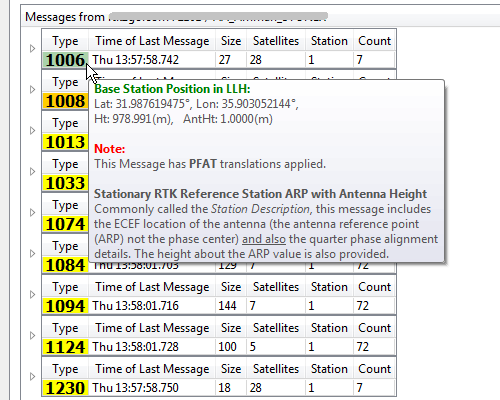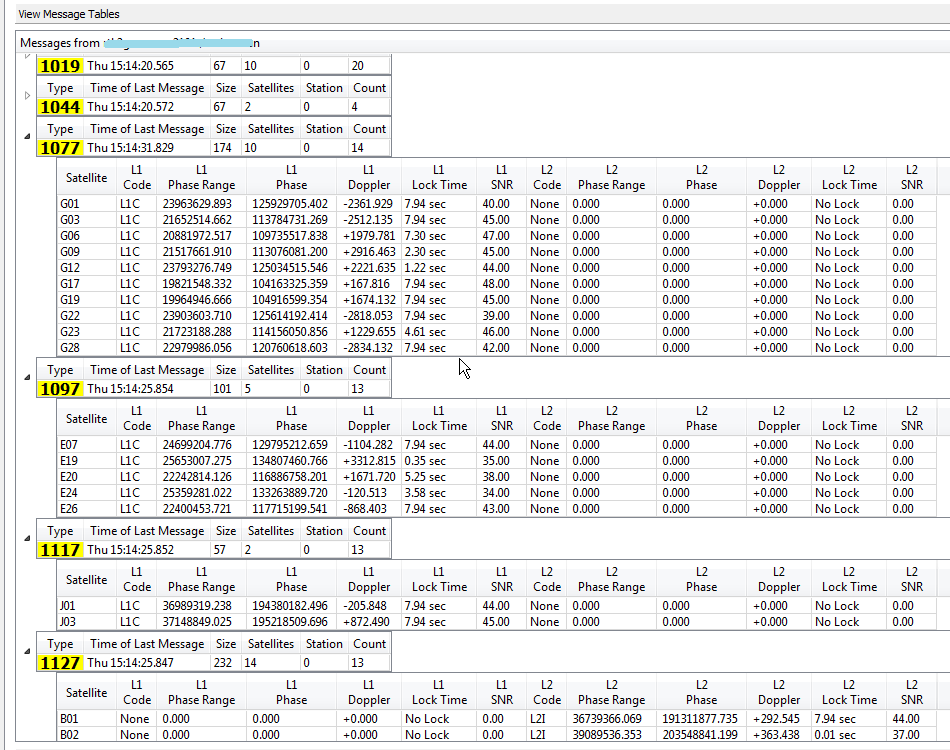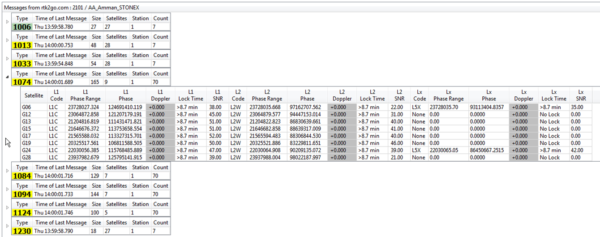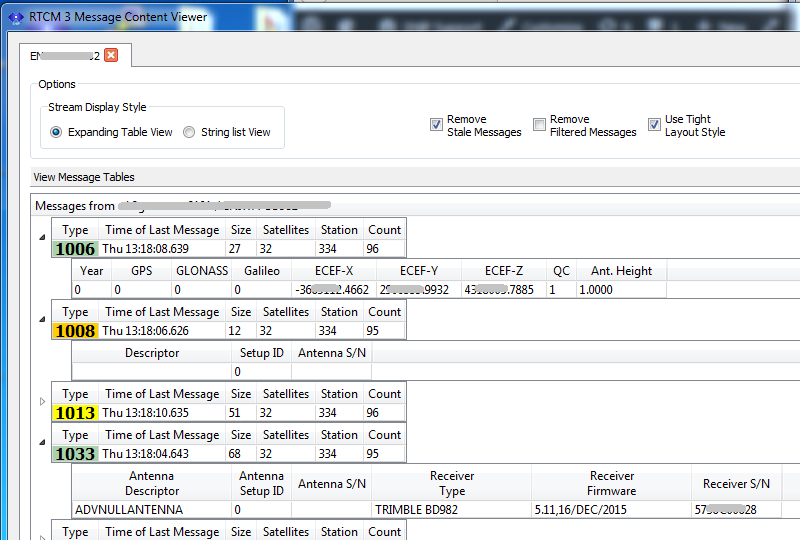SNIP supports the detailed decoding of all the MSM style RTCM3.x messages. This article briefly covers the new features (added in release 2.06). The basics of the RTCM Decoder dialog are covered in this article. This is a powerful tool is intended to assist the SNIP operator when any questions about the data stream contents arise.
The Universal Decoder and the ability to right-click and use the Show Message type menu are also helpful tools.
Additional Message Types
Simply put, the decoder now provides the same table & tree view for MSM messages as it does for the legacy messages. Support includes MSM3, MSM4, MSM5, MSM6 and MSM7 messages. And this is for all GNSS systems; GPS, GLO, GAL, QZSS, SBAS and Beidou/Compass. [click to enlarge image]
Support for the new MT1230 message (the GLO Signal Bias message) has also be added

And support for legacy MT1003 and MT1011 messages (a rarely used L1/L2 message but without any SNR data) has also been added
Support for the newest adopted Ephemerides messages (MT1042, MT1044, MT1045, MT1046) has also been added (older messages MT1019 (GPS) and MT1020 (GLO) were already present). These messages support the new GNSS types supported by MSM with basic orbital data.
Support for L3 /L5 signals
Display of the newer L5 / Lx signals has also been added, displaying a third frequency band when one is present. As the image below demonstrates, this can produce rather large tables (click to enlarge). Development in this area will continue as more Space Vehicles (SVs) with the new signals continue to come on-line and be defined by RTCM SC-104.
The Use of Color
The improved display now uses a simple highlight color indicate if a given message has been changed due to PFAT settings.
- The default color remains yellow.
- The orange color indicates that the message has been filtered (removed) from the data stream.
- The green color indicates that the message type or content has been changed due to an active PFAT translation.
- Data columns which are grey represent data that is not present in the subject message. For example, L2 data is not present in the MT1002 message – but is present in the MT1004 message. Grey columns may display data if it that content provided by another message, or if the original message contained it.
In the nonsensical image above (double click to enlarge) , the green color indicates that the MT1006 and MT1033 have been changed. The orange color indicates that the MT1008 has been filtered (removed) from the data stream. The yellow color (MT1013) is the default. Holding the mouse over the colored area bring up the SNIP summary remarks for this message type. In this example:
- MT1006 had a one meter Antenna Height added to the original message.
- MT1008 was removed, although sending this message with ADVNULLANTENNA would be more typical, as some older GNSS devices require this message because they cannot process the MT1033 information.
- MT1033 has has the term ADVNULLANTENNA added to it.
Improved Tool Tips
Whenever PFAT operations (such as ECEF offsets to the Base Station) are active, the tool tip text reflects this.
In MT1005 and MT1006 the ECEF data is also translated to human readable decimal LLH units and displayed.
The below example show both of these in use.

The String – List view
The RTCM3 Decoder dialog has two basic display modes, the Expanding Tree view used above, and textual list mode, now renamed the String List view. In the String List view, the decoded content of the messages (in their pre-PFAT formats) are shown. The data elements are typically shown closer to the style they are encoded in for over the air transmission. [By contrast the Expanding Tree view typically converts the content into whatever units make sense for a human reader and shows the results of any PFAT operations.]
And whenever a message has been modified by PFAT, short descriptive text is also prepended to the entry.
Misc Notes
- A textual alert label has been added to the bottom right hand corner to better indicate when the display is paused (no content updates will occur).
- Due the the larger amount of data to be displayed, a tighter layout design has been developed. For those that preferred the older layout style, a check box marked Use Tight Layout Style can be unchecked.
- A check box marked Remove Filtered Messages can be used to remove any message types that are being PFAT filtered from the display list to reduce clutter.
- A check box marked Remove Stale Messages will remove any message type entry wherever a new message has not arrived for over 30 seconds. This is checked by default. This is automatically disabled when the display is paused.
A final note regarding the misuse of this dialog. The dialog allows you to display many Base Station streams at once, each with as many expanded tree elements as you like. SNIP will then updates these as new data comes in. With a half a dozen streams displayed, and each open to show MSM or Legacy observation messages, SNIP can be updating over 3000 visual widgets every second, slowing responsiveness. SNIP will processes these items only after servicing the new data to all the clients, but it is a needless waste on your machine resources. It is recommend that the RTCM3 Decoder dialog be used as a debugging aid not displayed as a long term monitoring tool.




